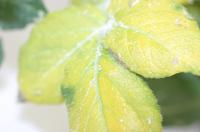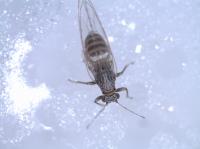
A yellowing infected potato plant. The white sugary-looking substance is psyllid excreta. The clear whitish substance is psyllid exoskeleton. To make a discovery and get to name it is just about every scientist's dream. For one graduate student at UC Riverside that dream already has come true.
Allison Hansen, a doctoral student in entomology, has discovered and named a new bacterial pathogen that could be responsible for "psyllid yellows," a disease that infects and kills tomato and potato plants. The disease is spread from plant to plant by the psyllid, a sap-sucking insect. This psyllid commonly is called potato psyllid or tomato psyllid, depending on the plant affected.
Hansen, who joined UCR in 2005 and expects to graduate next year, discovered the bacterium serendipitously through her research on the "symbionts" of the tomato psyllid. (A symbiont is an organism that has an intimate relationship with another organism of a different species.)
She named the pathogen "Candidatus Liberibacter psyllaurous." Liberibacter, she explained, is the genus – a category of biological classification – in which the bacterium is nested; psyllaurous means psyllid yellows in Latin.
"Allison has a special gift of looking at questions from new perspectives and recognizing relationships that others have either overlooked or missed all together," said Timothy Paine, Hansen's advisor and a professor of entomology. "This ability has enabled her to make a couple of key breakthroughs as a graduate student that have stumped other scientists for decades."
In tomato alone, psyllid yellows resulted in yield losses up to 85 percent and 50 percent in commercial tomato crops in western North America during 2001 and 2004, respectively. 
The tomato psyllid.
"One symptom of an infected tomato or potato plant with this bacterium is yellowing of the foliage," said Hansen, whose co-advisor is Richard Stouthamer, a professor of entomology. "The saliva of the tomato psyllid has been known to cause yellowing of tomato and potato leaves. The cause of this symptom has been a mystery for over a century."
Hansen's discovery has the potential to help plant breeders develop resistant cultivars of potato and tomato.
"What we know is that the bacterium is vectored by the tomato/potato psyllid into their tomato and potato host plants, subsequently causing yellowing and death to the plant," Hansen said. "This knowledge may help growers come up with alternative strategies for controlling this pest. We're now working in the lab to confirm whether Candidatus Liberibacter psyllaurous is the psyllid yellows-causing bacterium."
The new bacterium is closely related to huanglongbing or HLB disease, also known as citrus greening disease, so named because the disease causes the citrus fruit to retain some green spots even when the fruit is ripe.
"Huanglongbing is Chinese for yellow dragon disease," Hansen explained. "Chinese farmers call the young, infected yellowing shoots of citrus 'yellow dragons' because of the symptoms this disease causes in the plant."
To date, three other HLB bacteria have been identified, all of which primarily infect citrus. Hansen mentioned that a huge scientific effort currently is underway to study HLB of citrus, a disease that is threatening to destroy Florida's citrus industry.
Hansen, Stouthamer, Paine and John Trumble, a professor of entomology at UCR, reported the discovery of the new bacterium in a research paper published online, ahead of print, on Aug. 1 in the journal Applied and Environmental Microbiology.
"Liberibacter psyllaurous could be a good model system to come up with methods for combating citrus greening disease," Hansen said.
Currently she is looking at symbiont and psyllid interactions with host plants as well as other susceptible host plants of the bacterium. She also is trying to sequence the bacterium's genome.
Her research is funded by UCR's Department of Entomology.
Source : University of California - Riverside
 Print Article
Print Article Mail to a Friend
Mail to a Friend
